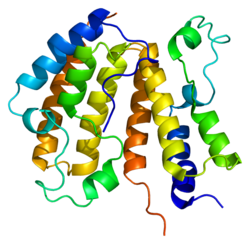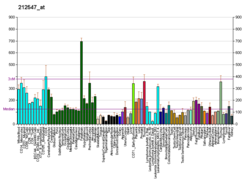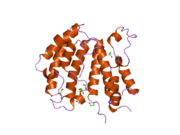Bromodomain-containing protein 3
| BRD3 | |||||||||||||||||||||||||||||||||||||||||||||||||||
|---|---|---|---|---|---|---|---|---|---|---|---|---|---|---|---|---|---|---|---|---|---|---|---|---|---|---|---|---|---|---|---|---|---|---|---|---|---|---|---|---|---|---|---|---|---|---|---|---|---|---|---|
 | |||||||||||||||||||||||||||||||||||||||||||||||||||
| |||||||||||||||||||||||||||||||||||||||||||||||||||
| Identifiers | |||||||||||||||||||||||||||||||||||||||||||||||||||
| Aliases | BRD3, ORFX, RING3L, bromodomain containing 3 | ||||||||||||||||||||||||||||||||||||||||||||||||||
| External IDs | OMIM: 601541; MGI: 1914632; HomoloGene: 81801; GeneCards: BRD3; OMA:BRD3 - orthologs | ||||||||||||||||||||||||||||||||||||||||||||||||||
| |||||||||||||||||||||||||||||||||||||||||||||||||||
| |||||||||||||||||||||||||||||||||||||||||||||||||||
| |||||||||||||||||||||||||||||||||||||||||||||||||||
| |||||||||||||||||||||||||||||||||||||||||||||||||||
| |||||||||||||||||||||||||||||||||||||||||||||||||||
| Wikidata | |||||||||||||||||||||||||||||||||||||||||||||||||||
| |||||||||||||||||||||||||||||||||||||||||||||||||||
Bromodomain-containing protein 3 (BRD3) also known as RING3-like protein (RING3L) is a protein that in humans is encoded by the BRD3 gene.[5][6][7] This gene was identified based on its homology to the gene encoding the RING3 (BRD2) protein, a serine/threonine kinase. The gene maps to 9q34, a region which contains several major histocompatibility complex (MHC) genes.
Structure
BRD3 is a member of the Bromodomain and Extra-Terminal motif (BET) protein family. Like other BET family members it contains two tandem homologous bromodomains and an "Extra-Terminal" motif.
BRD3, similar to BRD2, does not have a long C-terminal domain as BET family proteins BRD4 and BRDT do.[8]
Function
Like other BET protein family members, BRD3 associates with acetylated lysine residues on histones and transcription factors.[9][10]
BRD3 has been implicated in nucleosome remodeling in the context of transcription.[11] In addition, BRD3 has been shown to interact with RNA molecules and form protein-RNA aggregates.[12]
BRD2 and BRD3 perform overlapping cellular functions.[13]
Clinical significance
Chromosomal translocation of BRD3 with the NUT gene has been implicated in NUT midline carcinoma.[14] BRD3-NUT driven cancers are histopathologically indistinguishable from BRD4-NUT driven cancers, likely because these translocations involve the N-terminal portion bromodomain-containing portion of these proteins which are highly conserved.
Depletion of BRD3 slows growth in cancer models including prostate cancer and medulloblastoma. The effect of BRD3 depletion is milder than that of other BET proteins BRD2 and BRD4 when each is tested in isolation.[15][16] BET inhibitors target highly conserved BET bromodomains and displace BRD2, BRD3, and BRD4 from chromatin simultaneously. Functional redundancy between BRD2 and BRD3 suggests that their simultaneous disruption of these proteins may be more important than is appreciated by depletion of these proteins individually.[17]
References
- ^ a b c GRCh38: Ensembl release 89: ENSG00000169925 – Ensembl, May 2017
- ^ a b c GRCm38: Ensembl release 89: ENSMUSG00000026918 – Ensembl, May 2017
- ^ "Human PubMed Reference:". National Center for Biotechnology Information, U.S. National Library of Medicine.
- ^ "Mouse PubMed Reference:". National Center for Biotechnology Information, U.S. National Library of Medicine.
- ^ Nomura N, Nagase T, Miyajima N, Sazuka T, Tanaka A, Sato S, Seki N, Kawarabayasi Y, Ishikawa K, Tabata S (Dec 1995). "Prediction of the coding sequences of unidentified human genes. II. The coding sequences of 40 new genes (KIAA0041-KIAA0080) deduced by analysis of cDNA clones from human cell line KG-1". DNA Research. 1 (5): 223–9. doi:10.1093/dnares/1.5.223. PMID 7584044.
- ^ Thorpe KL, Abdulla S, Kaufman J, Trowsdale J, Beck S (Oct 1996). "Phylogeny and structure of the RING3 gene". Immunogenetics. 44 (5): 391–6. doi:10.1007/BF02602785. PMID 8781126. S2CID 44613743.
- ^ "Entrez Gene: BRD3 bromodomain containing 3".
- ^ Belkina AC, Denis GV (Jul 2012). "BET domain co-regulators in obesity, inflammation and cancer". Nature Reviews. Cancer. 12 (7): 465–77. doi:10.1038/nrc3256. PMC 3934568. PMID 22722403.
- ^ Gamsjaeger R, Webb SR, Lamonica JM, Billin A, Blobel GA, Mackay JP (Jul 2011). "Structural basis and specificity of acetylated transcription factor GATA1 recognition by BET family bromodomain protein Brd3". Molecular and Cellular Biology. 31 (13): 2632–40. doi:10.1128/MCB.05413-11. PMC 3133386. PMID 21555453.
- ^ Lamonica JM, Deng W, Kadauke S, Campbell AE, Gamsjaeger R, Wang H, Cheng Y, Billin AN, Hardison RC, Mackay JP, Blobel GA (May 2011). "Bromodomain protein Brd3 associates with acetylated GATA1 to promote its chromatin occupancy at erythroid target genes". Proceedings of the National Academy of Sciences of the United States of America. 108 (22): E159-68. doi:10.1073/pnas.1102140108. PMC 3107332. PMID 21536911.
- ^ LeRoy G, Rickards B, Flint SJ (Apr 2008). "The double bromodomain proteins Brd2 and Brd3 couple histone acetylation to transcription". Molecular Cell. 30 (1): 51–60. doi:10.1016/j.molcel.2008.01.018. PMC 2387119. PMID 18406326.
- ^ Daneshvar K, Ardehali MB, Klein IA, Hsieh FK, Kratkiewicz AJ, Mahpour A; et al. (2020). "lncRNA DIGIT and BRD3 protein form phase-separated condensates to regulate endoderm differentiation". Nat Cell Biol. 22 (10): 1211–1222. doi:10.1038/s41556-020-0572-2. PMC 8008247. PMID 32895492.
{{cite journal}}: CS1 maint: multiple names: authors list (link) - ^ Stonestrom AJ, Hsu SC, Jahn KS, Huang P, Keller CA, Giardine BM, Kadauke S, Campbell AE, Evans P, Hardison RC, Blobel GA (Feb 2015). "Functions of BET proteins in erythroid gene expression". Blood. 125 (18): 2825–34. doi:10.1182/blood-2014-10-607309. PMC 4424630. PMID 25696920.
- ^ French CA (2012). "Pathogenesis of NUT midline carcinoma". Annual Review of Pathology. 7: 247–65. doi:10.1146/annurev-pathol-011811-132438. PMID 22017582.
- ^ Asangani IA, Dommeti VL, Wang X, Malik R, Cieslik M, Yang R, Escara-Wilke J, Wilder-Romans K, Dhanireddy S, Engelke C, Iyer MK, Jing X, Wu YM, Cao X, Qin ZS, Wang S, Feng FY, Chinnaiyan AM (Jun 2014). "Therapeutic targeting of BET bromodomain proteins in castration-resistant prostate cancer". Nature. 510 (7504): 278–82. Bibcode:2014Natur.510..278A. doi:10.1038/nature13229. PMC 4075966. PMID 24759320.
- ^ Tang Y, Gholamin S, Schubert S, Willardson MI, Lee A, Bandopadhayay P, Bergthold G, Masoud S, Nguyen B, Vue N, Balansay B, Yu F, Oh S, Woo P, Chen S, Ponnuswami A, Monje M, Atwood SX, Whitson RJ, Mitra S, Cheshier SH, Qi J, Beroukhim R, Tang JY, Wechsler-Reya R, Oro AE, Link BA, Bradner JE, Cho YJ (Jul 2014). "Epigenetic targeting of Hedgehog pathway transcriptional output through BET bromodomain inhibition" (PDF). Nature Medicine. 20 (7): 732–40. doi:10.1038/nm.3613. PMC 4108909. PMID 24973920.
- ^ Stonestrom AJ, Hsu SC, Jahn KS, Huang P, Keller CA, Giardine BM, Kadauke S, Campbell AE, Evans P, Hardison RC, Blobel GA (Apr 2015). "Functions of BET proteins in erythroid gene expression". Blood. 125 (18): 2825–34. doi:10.1182/blood-2014-10-607309. PMC 4424630. PMID 25696920.
External links
- Human BRD3 genome location and BRD3 gene details page in the UCSC Genome Browser.
Further reading
- Thorpe KL, Gorman P, Thomas C, Sheer D, Trowsdale J, Beck S (Oct 1997). "Chromosomal localization, gene structure and transcription pattern of the ORFX gene, a homologue of the MHC-linked RING3 gene". Gene. 200 (1–2): 177–83. doi:10.1016/S0378-1119(97)00415-0. PMID 9373153.
- Kaneko H, Inoue R, Teramoto T, Morimoto W, Isogai K, Kasahara K, Kondo N (2003). "Detection of the genes induced in activated lymphocytes by modified differential display". Journal of Investigational Allergology & Clinical Immunology. 12 (2): 86–90. PMID 12371535.
- Zhou M, Peng C, Nie XM, Zhang BC, Zhu SG, Yu Y, Li XL, Li GY (Feb 2003). "[Expression of BRD7-interacting proteins,BRD2 and BRD3, in nasopharyngeal carcinoma tissues]". AI Zheng = Aizheng = Chinese Journal of Cancer. 22 (2): 123–7. PMID 12600283.
- Beausoleil SA, Jedrychowski M, Schwartz D, Elias JE, Villén J, Li J, Cohn MA, Cantley LC, Gygi SP (Aug 2004). "Large-scale characterization of HeLa cell nuclear phosphoproteins". Proceedings of the National Academy of Sciences of the United States of America. 101 (33): 12130–5. Bibcode:2004PNAS..10112130B. doi:10.1073/pnas.0404720101. PMC 514446. PMID 15302935.
- Ishii H, Mimori K, Mori M, Vecchione A (Jul 2005). "Differentially expressed genes in endothelial differentiation". DNA and Cell Biology. 24 (7): 432–7. doi:10.1089/dna.2005.24.432. PMID 16008511.
- Olsen JV, Blagoev B, Gnad F, Macek B, Kumar C, Mortensen P, Mann M (Nov 2006). "Global, in vivo, and site-specific phosphorylation dynamics in signaling networks". Cell. 127 (3): 635–48. doi:10.1016/j.cell.2006.09.026. PMID 17081983. S2CID 7827573.







